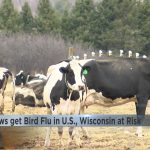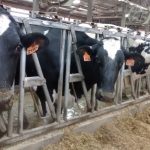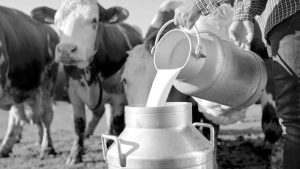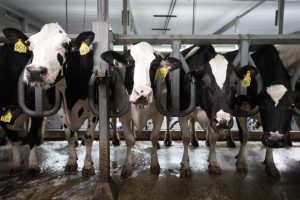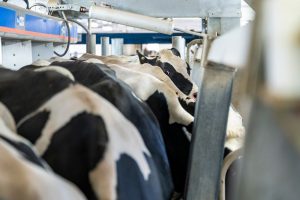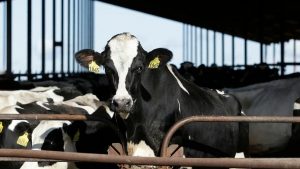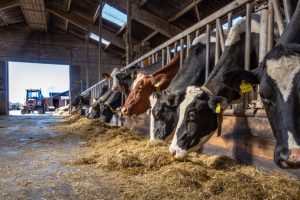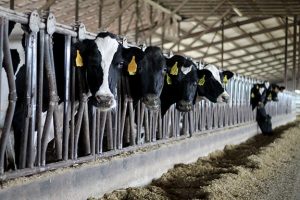
As many may have heard, Highly Pathogenic Avian Influenza (HPAI) has been found in dairy cattle in multiple states around the United States. Dairy cattle on a farm in Texas first showed unusual symptoms, including an unexpected drop in milk production, thick colostrum-like milk, and changes in manure consistency. On March 25, 2024, the United States Department of Agriculture (USDA) announced that those cases were confirmed as HPAI.
As of April 1, 2024, there have been cases of HPAI in dairy cattle confirmed in Texas (7), Kansas (2), Idaho, New Mexico (1), and Michigan (1). There is significant evidence that migratory waterfowl are the source of infection to dairy cows. Cow-to-cow spread is highly suspected, but the specific mode(s) of transmission (e.g., direct contact, inhalation, fomite, ingestion, vector) have not been determined. Follow the most recent updates about HPAI in dairy cattle from the USDA here.
What is HPAI?
Highly Pathogenic Avian Influenza, also known as avian flu or bird flu, is a disease caused by infection with avian Type A viruses. This virus is spread naturally among wild aquatic birds, but can infect other birds such as poultry or other animals. This virus is deadly to poultry, leading to high biosecurity measures with egg-laying or meat birds. While HPAI can infect humans, it is rare.
What does HPAI look like in dairy cattle?
Symptoms that have been seen include a drop in milk production, thickened or colostrum-like milk, appetite loss, manure inconsistencies, or a low-grade fever. Infected cows often show symptoms for 7-10 days before recovering. About 10% of cows do not recover fully and return to previous milk production, mainly those with the most severe symptoms. Those with severe symptoms have also been seen to develop secondary infections, such as mastitis, pneumonia, or salmonella. Most animals infected are cows in their second or greater lactation, in mid to late lactation.
Is milk still safe to drink?
Yes, pasteurized milk is still safe to consume. Cows that show symptoms of avian influenza infection should have their milk dumped. No matter the concern, only milk from healthy cows is sent to processing for human consumption. Pasteurization kills the virus, making all pasteurized milk completely safe to drink.
What about raw milk?
The avian influenza virus is found in unpasteurized (raw) milk samples. Virus in the milk is the primary method of diagnosis for cows sick with HPAI at this time. However, the exact ways the virus is transmitted (e.g., direct contact, inhalation, ingestion, fomite, vector) is currently unknown. Out of an abundance of caution, unpasteurized milk or milk products should not be consumed or fed to animals on the farm, e.g., cats, calves, pigs, etc. Raw milk producers should work closely with their veterinarian.
How can I protect my cattle?
Avoid bringing in new cattle to your farm and interacting with any other dairy cattle. It is important to avoid any livestock auctions, salebarns, or place where livestock are if you have dairy cattle on farm. If you often visit farms, santitize any clothing or footwear. If possible, restrict movement of cattle as much as possible. If symptoms occur, quarantine the animals and contact your veterinarian.
Another important consideration is keeping birds away from cattle. Use different tools to deter birds, some which can be found here.
Resources:
IDALS: HPAI Detection in Dairy Cattle
AVMA: Highly pathogenic avian influenza found in Texas, Kansas dairy cattle
NMPF: Joint Dairy Organizations Statement on Highly Pathogenic Avian Influenza in Cows
USDA: Highly Pathogenic Avian Influenza (HPAI) Detection in Livestock
The Livestock Project: Bird flu information for organic and alternative livestock producers
Farm Progress: Eight Ways to Control Pesky Birds in Feedlots, Barns
You can now read the most important #news on #eDairyNews #Whatsapp channels!!!
🇺🇸 eDairy News INGLÊS: https://whatsapp.com/channel/0029VaKsjzGDTkJyIN6hcP1K

